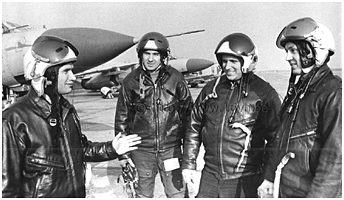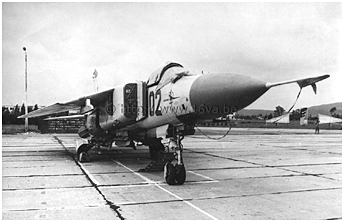
 Bill Burhans served as a tour officer with the USMLM Air Team from July 1971 to June 1975. He returned in 1979 to command Detachment 16,
7113th Special Activities Squadron (the Air Team), departing in early spring 1980 following a December 1979 Soviet-originated nasty incident.
He
recalls for us two visits at Falkenberg airfield in 1973 with different fortunes.
Bill Burhans served as a tour officer with the USMLM Air Team from July 1971 to June 1975. He returned in 1979 to command Detachment 16,
7113th Special Activities Squadron (the Air Team), departing in early spring 1980 following a December 1979 Soviet-originated nasty incident.
He
recalls for us two visits at Falkenberg airfield in 1973 with different fortunes.
Extensive MiG-23 FLOGGER Coverage
The MiG-23 was introduced into the 16th Air Army aircraft inventory in mid-1973 and assigned to the 31st Guards Fighter Aviation Regiment based at Falkenberg (formerly designated Alt Lönnewitz), south of Berlin. This aircraft was of considerable interest to the US intelligence community. Specifically, HQ US Air Forces in Europe was keenly interested in the capabilities of this fighter-interceptor and wanted to determine the level of threat it presented to the F-15 Eagle, the mainstay of the USAF fighter interceptor force. As a result, the Air Team at this time was focusing its attention on this priority target. Early in the morning on October 12, 1973 Larry Patterson, Mert Pennock and I worked hard to make our way undetected into the Falkenberg Soviet Airfield area. We had proceeded south from the Jüterbog area via Route 101 under the cover of darkness and took advantage of the automatic railroad drop barrier protecting the crossing at Bahnhof Beutersitz to reach our target. We established our standoff observation point in the woods that paralleled Route 101 just outside of Winkel and awaited flying activity.

The first observation point lay along the normal flight path for Falkenberg aircraft. Close to the PRA boundary, it was hard to get closer to the east end of the runway. Besides that, the terrain between the main road and the airfield perimeter fence (a distance of some 5 miles) was laced with streams. To top that off, the railroad tracks linking Falkenberg and Bad Liebenwerda represented a serious obstacle to escape should the need arise for the reconnaissance tour to have to vacate the area quickly. The weather was not too good: almost complete overcast and not too much light.

 We set up in the OP and took turns performing security to avoid being detained. As time passed, it became clear that nobody
realized we were in the area so we were able to relax a little bit. Suddenly we heard a lot of noise, obviously
motor vehicles, and not too far away. This turned out to be a tactical bridging unit probably based
near Bad Liebenwerda, on a road march north along Route 101 towards Jüterbog. We observed a regiment
equipped with PMP ponton sections (the usual 19 vehicles comprising 2 end sections, 16 center sections,
and the so-called "19th" vehicle that made up a PMP tactical ponton bridging company, plus a multitude of
support vehicles) and recorded our observations on magnetic tape. This was not anything earth-shaking
from an intelligence standpoint, but the noise of all those huge KrAZ-255B trucks carrying pontons and
other equipment certainly kept us from falling asleep!
In the end, our patience was rewarded, because the FLOGGER regiment began its flying operations. By
now it was getting quite late in the afternoon and we were about to lose the little bit of light we had. After
photographing a few aircraft in the landing pattern, we decided to move in as close to the
PRA boundary as possible since we had not detected any surveillance and felt quite safe.
As we were making our way across field trails and through open fields, Mert would stop the car so we
could get shots of the underside of the aircraft on final approach passing overhead. Unfortunately, by this
time the light was insufficient and our results were not very good. In addition, the flying program came to
an end and there was no further activity. We packed up our gear and departed the area.
We did accomplish one important thing during this collection mission. We were able to document the key
fact that the FLOGGER engine produced a distinct smoke trail, making it very easy to visually acquire an
approaching aircraft from a great distance.
We set up in the OP and took turns performing security to avoid being detained. As time passed, it became clear that nobody
realized we were in the area so we were able to relax a little bit. Suddenly we heard a lot of noise, obviously
motor vehicles, and not too far away. This turned out to be a tactical bridging unit probably based
near Bad Liebenwerda, on a road march north along Route 101 towards Jüterbog. We observed a regiment
equipped with PMP ponton sections (the usual 19 vehicles comprising 2 end sections, 16 center sections,
and the so-called "19th" vehicle that made up a PMP tactical ponton bridging company, plus a multitude of
support vehicles) and recorded our observations on magnetic tape. This was not anything earth-shaking
from an intelligence standpoint, but the noise of all those huge KrAZ-255B trucks carrying pontons and
other equipment certainly kept us from falling asleep!
In the end, our patience was rewarded, because the FLOGGER regiment began its flying operations. By
now it was getting quite late in the afternoon and we were about to lose the little bit of light we had. After
photographing a few aircraft in the landing pattern, we decided to move in as close to the
PRA boundary as possible since we had not detected any surveillance and felt quite safe.
As we were making our way across field trails and through open fields, Mert would stop the car so we
could get shots of the underside of the aircraft on final approach passing overhead. Unfortunately, by this
time the light was insufficient and our results were not very good. In addition, the flying program came to
an end and there was no further activity. We packed up our gear and departed the area.
We did accomplish one important thing during this collection mission. We were able to document the key
fact that the FLOGGER engine produced a distinct smoke trail, making it very easy to visually acquire an
approaching aircraft from a great distance.
|
According to USMLM reports, the 31.GIAP was equipped with "Fishbed-D" (MiG-21PF/PFS) and "Fishbed-F" (MiG-21PFM)
when the unit started its conversion to MiG-23. Apparently, the regiment received its first MiG-23s in 1973. However, it is not clear
whether the unit was already equipped with some single-seater that year; it is quite possible that only a few
MIG-23UB "Flogger-C" twin-seaters had been delivered. Also, it is not clear which single-seater version was delivered initially to the
regiment: MiG-23S early version or MiG-23M. It seems however probable
that they took the latter model on charge from the beginning. As a matter of fact, the unit flew MiG-23M fighter-bombers during the
seventies. Here is an excerpt from the USMLM annual report for 1973: |
 |
Falkenberg Adventures > Part 2 |
 |
Plan du site - Sitemap |  |
